srImathE rAmAnujAya nama:
srImadh varavaramunayE nama:
srI vAnAchala mahAmunayE nama:
gOpAlakrishNa dhAsar (kOnAr) who was living in chennai and a sishya of
kOil kandhAdai vAdhUla aNNan swamy compiled a set of beautiful
phrases/sentences from nampiLLai‘s eedu (documented by vadakku thiruvIdhi piLLai) vyAkyAnam long ago. kOil vidhwAn srI U. vE. R
narasimhAchAryar swamy (paramapadhavAsi) wrote simple thamizh meanings
for those phrases/sentences. This book (https://docs.google.com/file/d/0ByVemcKfGLucbWJNTUMzVS1KTzA/edit?usp=sharing) was originally released on 7-1-68 and
was re-published by puthur raghurAman swamy (editior: srI sailEsa
dhayApAthram magazine). In this series we are relishing this great compilation with the english translation for the same.
தாமஸ புருஷர்களோட்டை ஸஹவாஸம் ஸர்வேச்வரனுக்கு த்யாக ஹேது. ஸத்வநிஷ்டரோட்டை ஸஹவாஸம் ஈச்வரனுக்கு ஸ்வீகார ஹேது.

thirumazhisai AzhwAr who is parama sAthvikar (and thus most worshippable) established clearly that one should avoid dhEvathAntharams at all cost
Translator’s note: emperumAn is guiding every jIvAthmA always. But when the jIvAthmA does not understand the true nature of the self and associates with ignorant persons that will be detrimental for the jIvAthmA. dhEvathAntharams are generally categorized as thAmasa purushas due to their bondage in samsAram and thinking of themselves as capable of giving benedictions to others. On the other hand, association with srIvaishNavas (who are pure) is most beneficial since that will lead towards bhagavAn.
thirumazhisai AzhwAr identifies in nAnmugan thiruvanthAdhi 68th pAsuram that srIvaishNavas would never worship dhEvathAntharams – “thiruvadi than nAmam maRanthum puRam thozhA mAnthar” (திருவடி தன் நாமம் மறந்தும் புறம் தொழா மாந்தர்).
thirumangai AzhwAr explains this principle beautifully in thirukkaNNapuram padhigam in periya thirumozhi – 8.10.3.
maRRumOr dheyvam uLadhenRu iruppArOdu uRRilEn
uRRadhum un adiyArkku adimai
maRRellam pEsilum nin thiruvettezhuththum
kaRRu nAn kaNNapuraththuRai ammAnE
மற்றுமோர் தெய்வம் உளதென்று இருப்பாரோடு உற்றிலேன்
உற்றதும் உன் அடியார்க்கு அடிமை
மற்றெல்லம் பேசிலும் நின் திருவெட்டெழுத்தும்
கற்று நான் கண்ணபுரத்துறை அம்மானே
Oh, the lord of thirukkaNNapuram! I will not associate with any one who believes that there is another God than srIman nArAyaNan. After understanding the thirumanthram (ashtAkshari), I declare that I am servant of your servants.
Here, we can observe that AzhwAr is saying “I will not associate with the devotees of dhEvathAntharams” – he is not just saying that “I will not associate with dhEvathAntharams”. Similarly, he is saying “I will serve your servants” – he is not just saying “I will serve you”.
In srIvachana bhUshaNam, piLLai lOkAchAryar highlights the glories of srIvaishNavas very beautifully. In sUthram 221, he says that:
vEdhagap pon pOlE ivargaL pakkal sambhandham.
வேதகப் பொன் போலே இவர்கள் பக்கல் ஸம்பந்தம்.
An alchemist carries a material which can convert iron into gold. Just like that, relationship with bhAgavathas will convert some one from an impure state to a very pure state and qualify them to receive the grace of bhagavAn.
- pAsuram 69 – Just like when something comes in contact with an object which has nice fragrance will also develop such fragrance, when some one comes in contact with srIvaishNavas who are sAthvik in nature, they will also develop such good qualities.
- pAsuram 70 – Just like when something comes in contact with an object which stinks will also develop a bad smell, when some one comes in contact with persons of undesirable qualities, they will also develop such undesirable qualities.
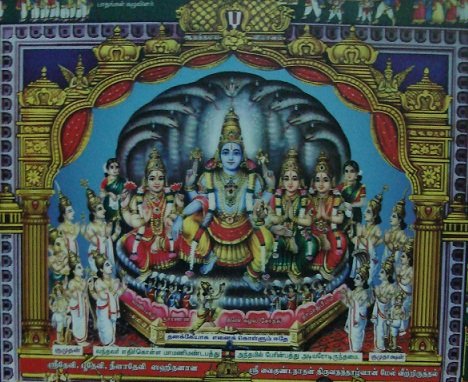
To fully enjoy the vision of srIman nArAyaNan seated in the blissful maNdapam (assembly) being served by nithyasUris is the goal to be achieved.
ஸ்வரூபஜ்ஞானம் பிறந்தவிடத்தில் ஸ்வரூபவிரோதியாக ப்ரவர்த்திக்கப் போகாதிறே.
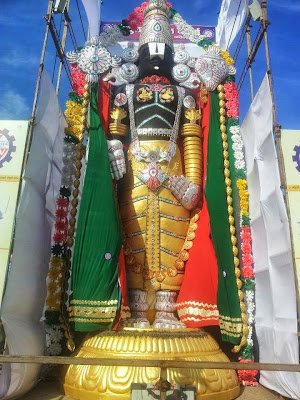
After understanding the true nature of jIvAthmA, he cannot do what is contrary to the true nature.
Translator’s note: svarUpam – true nature. Understanding the true nature of jIvAthmA means understanding him as athyantha parathanthran (totally dependent entity) of bhagavAn and also that the jIvAthmA is the in-dwelling soul that is different from body. svarUpa virOdhi means that which are contradictory to the nature of jIvAthmA and that which are hurdles in jIvAthmA realizing the true nature and practising the same. Here one needs to eliminate the following virOdhis:
- dhEhAthma abhimAnam – considering that the AthmA and the body are one and the same and leading a life that is focussed on the body. This needs to be elimiated – understading that the jIvAthmA is the soul that is eternal/permanent and the body is temporary, this can be overcome.
- anya sEshathvam – considering oneself as subervient to other dhEvathas – jIvAthmA is owned by bhagavAn only. He is thus not to have any servitude towards any other dhEvathas. By understanding the true nature of bhagavAn as the owner of all entities, this can be overcome.
- sva svAthanthriyam – considering jIvAthmA as svathanthran (independent). Even after giving up anya sEshathvam, one may still consider he is the master of himself. But understanding that bhagavAn is controller of everything, this can be overcome.
The above principles are explained in detail in https://granthams.koyil.org/kilaroli-ilamai/.
pEyAzhwAr highlights the importance for developing the taste for bhagavath vishayam and the result of the same in mUnRAm thiruvanthAdhi pAsuram 14.
mARpAl manam chuzhippa mangaiyar thOL kai vittu
nURpAl manam vaikka noyvidhAm
nARpAla vEdhaththAn vEngadaththAn
viNNOr mudi thOyum pAdhaththAn pAdham paNindhu
மாற்பால் மனம் சுழிப்ப மங்கையர் தோள் கை விட்டு
நூற்பால் மனம் வைக்க நொய்விதாம்
நாற்பால வேதத்தான் வேங்கடத்தான்
விண்ணோர் முடி தோயும் பாதத்தான் பாதம் பணிந்து
thiruvEnkatamudaiyAn who is residing in thiruvEnkatam is the object of the four vEdhas and the one whose lotus feet are touched by the crowns in the heads of nithyasUris. When one surrenders to his lotus feet and focusses his mind on thiruvEnktamudaiyAn, that will lead to him giving up attachment to wordly pleasures (the embracing of women, etc) and facilitate engaging oneself in studying the scriptures easily.
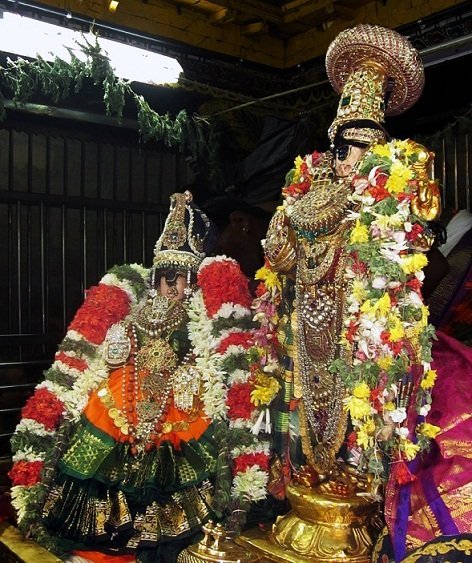
It is sufficient to have a good AchAryan who constantly instructs to the sishyas that only srIman nArAyaNan is the total refuge and no one else qualifies to be approached.
Translator’s note: AchAryan is the one who studies sAsthram, follows it himself and guide others towards the same. A true AchAryan means he is a devoted servitor of vishNu and vaishNavas and is simply focussed on upliftment of jIvAthmAs to lead them to perform eternal kainkaryam to bhagavAn. If a person comes into contact with such AchAryan and receives the most valuable instruction that “srIman nArAyaNan is the master and refuge for everyone” and the person simply accepts that and follows the principles as taught by such AchArya, that itself will uplift that jIvAthmA. The principle of srIman nArAyaNan being both upAyam (means) and upEyam (goal) is precisely explained in dhvaya mahA manthram and that is why our pUrvAchAryas held this manthram with great esteem.
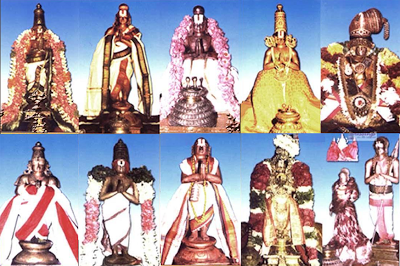
Translator’s note: AzhwArs were fully focussed on rendering blemishless kainkaryam and often prayed to emperumAn to fully engage them in such blemishless kainkaryam. A question may arise “What defects could creep upon our kainkaryam (service)?”. This is explained in mumukshuppadi by piLLai lOkAchAryar towards the end of dhvaya prakaraNam (section) while explaining “nama:” shabdham in the second part of dhvaya mahA manthram. This is most relishable explanation by piLLai lOkAchAryar which can be understood fully/properly with the help of mAmunigaL‘s divine commentary. Let us see that now.
- sUthram 178 – “nama: kainkaryaththil kaLai aRukkiRathu” (நம: கைங்கர்யத்தில் களை அறுக்கிறது) – nama: removes the weeds (unwanted elements) in our kainkaryam. Here, mAmunigaL highlights that nama: is usually explained in removing ahankAram and mamakAram, in this context since kainkaryam to srIman nArAyaNan is explained in the second part of dhvaya mahA manthram, this “nama:” removes the aspects that are detrimental to such service.
- sUthram 179 – “kaLaiyAvathu – thanakkennap paNNumathu” (களையாவது – தனக்கென்னப் பண்ணுமது) – The weed/defect here is to perform kainkaryam for ones own satisfaction. Any kainkaryam is focussed on bringing happiness to bhagavAn. Even if there is a tinge of self-enjoyment that could lead to defects.
- sUthram 180 – “ithilE avidhyAdhigaLum kazhiyuNNum” (இதிலே அவித்யாதிகளும் கழியுண்ணும்) – Further, this nama: also removes avidhyA, karma, janma, etc – the vicious cycle of ignorance, actions with puNyam/pApam as result, birth, etc.
- sUthram 181 – “‘unakkE nAmAtcheyvOm’ ennumpadiyE AgavENum” (‘உனக்கே நாமாட்செய்வோம்’ என்னும்படியே ஆகவேணும்) – ANdAL also highlights the same principle in thiruppAvai 29th pAsuram by saying “We will serve your interests only”. kainkaryam should not be done to fulfill a) our desire and b) our desire and emperumAn’s desire. It should be done to fulfill emperumAn’s desire only.
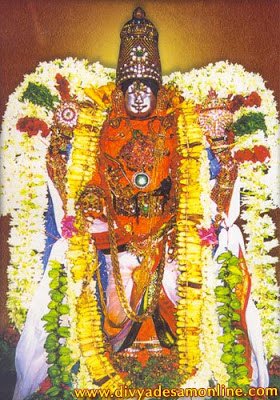
Ones who understand that “samsAram is to be given up and emperumAn is the goal” and surrender to emperumAn will also understand that to be cured of this disease called samsAram, they will consider bhagavAn himself as the medicine and will ultimately be situated to accomplish the ultimate goal of reaching bhagavAn in parampadham.
Translator’s note: This principle is beautifully explained by periyAzhwAr in periyAzhwAr thirumozhi 5.3.6.
eruththuk kodiyudaiyAnum biramanum indhiranum
maRRum oruththarum ippiRavi ennum nOykku marunthaRivArumillai
un kOyil kadaip pugappey thirumAlirunchOlai enthAy
எருத்துக் கொடியுடையானும் பிரமனும் இந்திரனும்
மற்றும் ஒருத்தரும் இப்பிறவி என்னும் நோய்க்கு மருந்தறிவாருமில்லை
மருத்துவனாய் நின்ற மாமணிவண்ணா மறு பிறவி தவிரத் திருத்தி
உன் கோயில் கடைப் புகப்பெய் திருமாலிருஞ்சோலை எந்தாய்
Oh my dear father who is residing in thirumAlirunchOlai (azhagar emperumAn)! rudhran who has the bull in his flag, bramhA (who is most knowledgable – yet does not understand bhagavAn fully), indhiran who is the king of the svargam and no one else can cure us of this disease called samsAram. So, you being the AchArya (spiritual doctor) please cure me of this disease and engage me in your kainkaryam.
periyavAchAn piLLai beautifully explains this pAsuram – let us see some of the highlights here.
- samsAram itself is considered as a disease. Four maladies are usually identified with samsAram – janma (birth), mruthyu (death), jarA (old-age), vyAdhi (disease). Birth is the root cause of the other maladies – so if we are able to stop our birth in this samsAram, that itself will relieve us.
- bull is considered to be the best example for ignorance. Since rudhran has the bull in his flag, he is considered as a thAmasa dhEvathai.
- brahmA is most knowledgable yet he does not understand bhagavAn fully – so he too cannot cure the disease of samsAram.
- All these dhEvathAs are considered as samsAra varththakar – the ones who increase our bondage in samsAram. To establish that fact, when krishNa went to kailAsam to pray to rudhran (as part of a boon which rudhran requested from emperumAn – that emperumAn asks for something from rudhran), he demonstrates that bhagavAn is the only one who can bestow mOksham by blessing gaNtA karNan (and his brother).
- bhagavAn is glorified as the medicine, the doctor and the enjoyable nectar by AzhwArs in other places – this quality of him being all at the same time cannot be seen in any other entity.
- Finally, it is identified that having a glorious life in his temple is the ultimate goal – as periyAzhwAr himself identifies in periyAzhwAr thirumozhi 5.1.3 “un kOyilil vAzhum vaittaNavan ennum vanmai kaNdAyE” (உன் கோயிலில் வாழும் வைட்டணவன் என்னும் வன்மை கண்டாயே) – the ultimate goal is to be a vaishNava who lives in your temple fully serving you. vAzhchhi means upliftment – which is at the lotus feet of emperumAn only.
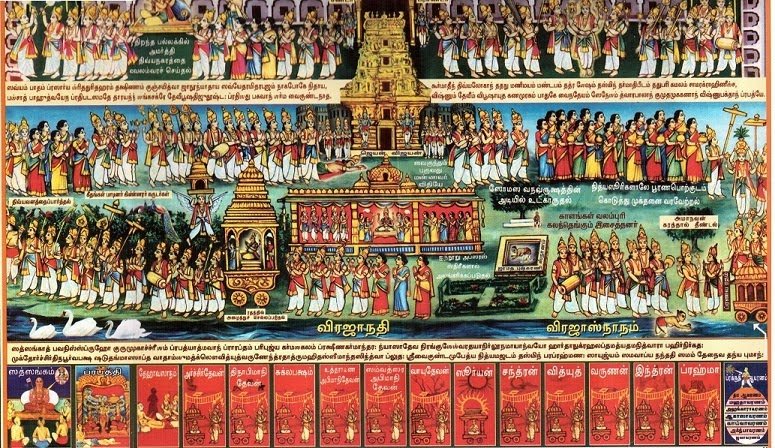
As sarvEsvaran (supreme lord) is the achievable goal, archirAdhi mArgam (the path that leads to him) and paramapadham (where he lives with his divine consorts and many other nithyasUris and mukthAthmAs) are also part of the achievable goal.
Translator’s guide: prApyam means purushArththam – that which is desired/achieved by a person. In kaNNinuN chiruthAmbu vyAkyAna avathArikai identifies the three levels of purushArththams.
- adhamam – low – based on achith (matter) – material/worldly pleasures – these are temporary and insignificant
- madhyamam – middle – based on chith (self) – kaivalyam (enjoying oneself) – even though one is freed from samsAram in this state, this is permanent and blissful – yet in comparison to enjoying bhagavAn‘s divine and auspicious qualities, this is insignificant too.
- uththamam – top most – based on Ishwara (bhagavAn) – kainkaryam to bhagavAn is considered as the top most goal since bhagavAn is filled with auspicious qualities and any service to him out of loving affection is blissful and natural for the jIvAthmA.
Thus bhagavAn is considered as the top most enjoyable goal.
When a mumukshu (jIvAthmA who desires for mOksham) gives up his body in this samsAram, Athi vAhikas (dhEvathas who are controllers for various lOkas) lead the jIvAthmA upto virajA river which runs between samsAram and paramapadham through archirAdhi gathi (path). archirAdhi means “starting with archis” – this includes the lOkas of the controlling dhEvathas of archis, ahas, sukla paksha, uththarAyaNa, samvathsara, vAyu, sUrya, chandhra, vidhyuth, varuNa, indhra and brahma lOkams.The jIvAthmA travels through the many lOkams, crosses the mUla prakruthi (primordial matter) and finally lands at the banks of virajA river. After crossing the river, he gets a divine spiritual body and he reaches bhagavAn in paramapadham and engages in eternal service to him. It is explained that the journey through the archirAdhi gathi itself is most relishable as explained in chAndhOgya, vAjanEya and kaushIdhakI upanishadhs. This is also explained beautifully by nammAzhwAr in his “chUzh visumbaNimugil” (சூழ் விசும்பணிமுகில்) padhigam in thiruvAimozhi (10.9). piLLai lOkAchAryar has also written a beautiful rahasya grantham named “archirAdhi” which explains the journey of jIvAthmA from samsAram to paramapadham.
emperumAnAr beautifully narrates the brilliant and wonderful aspects of paramapadham in a detailed manner in srI vaikunta gadhyam. He explains that the environment in paramapadham is most serene and blissful and most condusive for the jIvAthmA to serve bhagavAn in the purest possible way since everything is spiritual there. piLLai lOkAchAryar also gives a very beautiful narration of paramapadham in his “archirAdhi”.
From the above, we can understand that as kainkaryam to emperumAn is the top most goal to be achieved, paramapadham where we perform eternal kainkaryam and the path that takes us to paramapadham are also part of that achievable goal.
Explanation for the above picture:
- In the bottom section,
- first box shows the jIvAthmA coming into contact with an AchAryan and bhAgavathas
- second box shows the jIvAthmA giving the body
- from then on each box represents each lOkam/dhEvathA – archis, ahas, etc. jIvAthmA travels in praNava (OmkAra) ratham (chariot).
- last box shows the mUla prakruthi (saptha AvaraNam)
- going up, next is the virajA river with swans – jIvAthmA takes a dip in that and then acquires a spiritual body
- After crossing the river – amAnavan touches the jIvAthmA and allows him inside paramapadham.
- jIvAthmA is then welcomed by the nithyasUris and is decorated by apsaras (divine servitors of emperumAn assuming the form of beautiful ladies).
- Then after, the jIvAthmA travels up to the main entrance accompanied by nithya sUris who celebrate the arrival of jIvAthmA.
- Finally, he enters the main entrance and goes around the maNimAmaNdapam (where emperumAn is seated with dhivya mahishis) and enters the maNdapam and emperumAn accepts him. (not in this picture – but jIvAthmA climbing the AdhisEshan is seen in the paramapadhanAthan picture seen at the top – 142nd entry).
உபாஸன பலமாய் வருமவையடைய ப்ராப்யாந்தர்கதமாகக் கடவது. ஸாத்ய விவ்ருத்திக்குடலாய் வருமவையெல்லாம் பலத்துக்கு உடலாகக் கடவது. ஆகையாலே ப்ராப்ய பூமி அத்தேசமே. அங்கே கொண்டுபோய்ச் சேர்க்கும் கடகனவனே.
The results of upAsanam that is explained in vEdhAntham are part of the ultimate goal (kainkaryam). The ideal result that fits the true nature of jIvAthmA is kainkaryam. That which helps achieve the goal is the cause/means. Thus, the ultimate place to reach is parampadham only. The one who brings us there is also bhagavAn himself.
Translator’s note: Whatever that comes as a result of ones actions/practice towards the goal, those also become part of the goal. Please see previous entry for more detailed explanation.
அநுகூலரிலே ஒருவனுக்கொரு நன்மையுண்டானால் அது தன்னதாக நினைத்திருக்கையும் அநர்த்தம் வந்தால் அது தனக்கு வந்ததாக நினைத்திருக்கையும் ஆகிற இவ்விரண்டும் உண்டானாலிறே வைஷ்ணவத்வம் உண்டாயிற்றாவது.

A srIvaishNava means one who shares the happiness and sorrows of another srIvaishNava who is filled with gyAnam, bhakthi and vairAgyam. A srIvaishNava would also consider such joys and sorrows as if they happened to himself.
Translator’s note: anukUlar means one who is favourable towards emperumAn generally. The epitome of srIvaishNavam is to share the joy and sorrow of other srIvaishNavas.
In several pAsurams, AzhwArs highlight two charithrams more often than others. bhagavAn helping gajEndhrAzhwAn and accepting his service and bhagavAn helping prahlAdhaAzhwAn. Our pUrvAchAryas highlight that, AzhwArs consider when bhagavAn helps gajEndhrAzhwAn, prahlAdhAzhwAn, etc., he is helping AzhwArs themselves – they feel so much joy when bhagavAn helps his devotees.

Even after uplifting all the 3 worlds, that which is to be uplifted/protected by emperumAn will look small and emperumAn’s desire to uplift jIvAthmAs will look much larger.
Translator’s note: jIvAthmA’s svarUpam (true nature) is to seek protection from bhagavAn (seeking protection by performing sharaNAgathi is not an upAyam (means) – some may consider it as such). bhagavAn‘s svarUpam is to protect jIvAthmA (it is not aupAdhikam – based on some action of the jIvAthmA). In srI rAmAyaNam, sIthA pirAtti highlights “Anrusamsyam parO dharma:” (ஆந்ருசம்ஸ்யம் பரோ தர்ம: – compassion towards others is the most important quality of you). Also, srI rAma forgives kAkAsura out of his great compassion even after kAkAsura committing the most abominable offense as highlighted in “krupayA paryapAlayath” (க்ருபயா பர்யபாலயத் – protected by the mercy). These principles are reflected by ANdAL nAchiyAr in thiruppAvai 8th pAsuram. She says in the end of that pAsuram “dhEvAdhi dhEvanai chenRu nAm chEviththAl A A enRu Araynthu aruLElOr empAvAy” (தேவாதி தேவனை சென்று நாம் சேவித்தால் ஆ ஆ என்று ஆராய்ந்து அருளேலோர் எம்பாவாய்) – When we go and worship emperumAn, due to his natural tendency to protect his devotees, with great desire and enthusiasm, he will bless us. periyavAchAn piLLai, azhagiya maNavALa perumAL nAyanAr and Ay jananyAchAryar – the 3 commentators for thiruppAvai vyAkyAnam adequately quote from srI rAmAyaNa slOkams that are shown previously to explain the same principle.
thirumangai AzhwAr highlights the same principle in thirunIrmalai padhigam in 2.4.6 pAsuram.
பாரார் உலகும் பனிமால் வரையும் கடலும் சுடரும் இவை உண்டும்
எனக்கு ஆராதென நின்றவன் எம்பெருமான்
அலை நீர் உலகுக்கு அரசாகிய அப்பேரானை முனிந்த முனிக்கரையன்
பிறரில்லை நுனக்கெனும் எல்லையினான் நீரார் பேரான் நெடுமால் அவனுக்கு இடம் மாமலையாவது நீர்மலையே
During mahA praLayam, bhagavAn inhales the entire manifested universe into him and keeps them safely during such catastrophy. Here thirumangai AzhwAr says “Even after consuming (to protect them) the bhUlOkam, the mountains, the oceans, the sun, etc – he is not satisfied and is looking for more entities to show his compassion and protect them. Such emperumAn descended into this world as parasurAma (svarUpa AvEsha avathAram – where emperumAn manifests himself into a jIvAthmA) and killed kArthavIryArjuna (who himself is a shakthi AvEsha avathAram – where emperumAn manifests his power on a jIvAthmA) and many other kings who were filled with pride. Such emperumAn who has no match for himself manifests in this thirunIrmalai dhivya dhEsam as nIrvaNNar”.
Dear Sarathy Swami,
Srimathe ramanujaya namah:
Thank you very much for the delightful translation of the text.
Swamy, regarding the entry no 142, devareer has mentioned : "To fully enjoy the vision of srIman nArAyaNan seated in the blissful maNdapam (assembly) being served by nithyasUris is the goal to be achieved."
Swamy, adiyen also heard many times that Perumal is in a "amarndha" thirukollam at Sri-Vakuntam along with devi-margals. Does that mean Perumal would not manifest Himself in various vibhava avatarams (like Rama, Kannan, Varaha, Hayagriva etc) or in various diyva desam thirukkolams or postures? (i.e Varadaraja Perumal, Azhagar, Oppiliappan, Anbil etc, loads of different kolams and pastimes). When Kannan spent time in Gokulam and Brindhavan, He used to go for fun rides with cow-herd boys, did many marvellous pastimes, had pastimes with Gopi margal, govardhana lifting etc. In Rama avataram, His journey with Sita piratti in forests were also pastimes.
When Rama asked Hanuman to come with Him to Sri-vaikuntam, Hanuman refused to come since He would be unable to worship Rama and Sita there, only Vaikuntanatha with four-thiru-Hands would be there.
So, Swamy, all kinds of vibhava and archa perumal with their own unique auspicious qualities, divine forms and pastimes would also be there in Sri-vaikuntam or is it just the Perumal in amarndha tirukkolam??
Thanking you,
Gautam
thanks for the feedback.
emperumAn manifests all different forms (vaikuntam means the place where there is no limitations/defects) and since jIvAthmA becomes fully pure, he will be able to serve emperumAn in various ways. But the primary goal is to see that most auspicious and divine vision of emperumAn being seated in the maNimAmaNdapam along with his dhivya mahishis being surrounded by the nithyasUris.
adiyen sarathy ramanuja dasan
Dear Swamy,
Thank you very much for providing the reply. adiyen understood the import of the reply.
Thanking you,
Gautam
மன்னுயிர்காள் இங்கே மணவாளமாமுனிவன்
பொன்னடியாஞ் செங்கமலப் போதுக்ள
உன்னிச் சிரத்தாலே தீண்டில் அமானவனும் நம்மை
கரத்தாலே தீண்டல் கடன்
By prostrating at the Ponnadiyam sengalam of MM we are assured of direct entry into Paramabhadam since Amanavan is dutybound to hold us by the hand and take the soul inside.
https://fbcdn-sphotos-d-a.akamaihd.net/hphotos-ak-prn1/156748_468239596559428_466329337_n.jpg
This comment has been removed by the author.
In hindi – https://granthams.koyil.org/2023/10/15/divine-revelations-of-lokacharya-15/